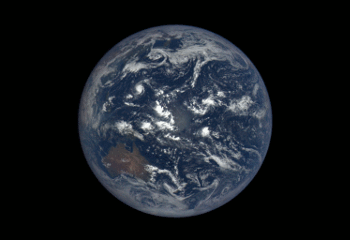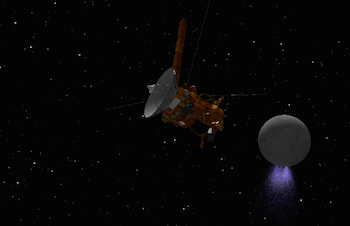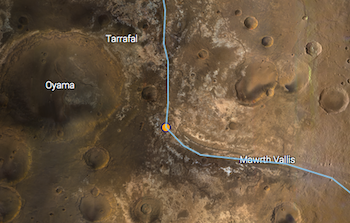Pluto - Blog Posts
Solar System: Top 5 Things to Know This Week
Here are five things you need to know about our amazing solar system this week:
1. Perpetual Pluto-palooza

The New Horizons spacecraft continues its ongoing download of data and images from the July 14 flyby of the Pluto system. In the latest weekly release, the new images don’t disappoint, showing fine details in an exotic landscape. The New Horizons team has also described a wide range of findings about the dwarf planet’s system in its first science paper. Learn more HERE.
2. Encounter at Enceladus

The Cassini spacecraft has returned the closest images ever showing the north polar region of Saturn’s intriguing ice moon Enceladus. Scientists expected the area to be heavily cratered, but the new high-resolution Cassini images also show a landscape of stark contrasts, crisscrossed by a spidery network of gossamer-thin cracks that slice through the craters. The robotic spacecraft buzzed by the moon during the first of what will be three close encounters this year -- the last of the long mission. Next up: on Oct. 28 Cassini will deep dive right through Enceladus’ famous ice geyser plume! Learn more HERE.
3. We’re Giving You the Whole World, Every Day

We have worked with NOAA to launch a new website that shows the full, sunlit side of the Earth on a daily basis. The images come from our camera a million miles away aboard the Deep Space Climate Observatory (DSCOVR). Each daily sequence of images shows the Earth as it rotates, revealing the entire planet over the course of a day. Take a look HERE.
4. Going Big at Jupiter

We have large, new maps of Jupiter, thanks to data from the Wide Field Camera 3 on our Hubble Space Telescope. The big images provide a detailed look at how the giant planet’s features change over time. In fact, the maps are just the first in a planned series of yearly portraits of the solar system’s four outer planets. The views come as we prepare for the Juno mission to arrive at Jupiter in little less than a year.
5. Catch a Falling Star

Meteors aren’t really falling stars, just dust and rock from deep space meeting a fiery end in Earth’s atmosphere -- but they’re a sight to behold if you can catch a glimpse. The Orionid meteors appear every year around this time, when Earth travels through an area of space littered with debris from Halley’s Comet. This year the peak will occur on the night of Wednesday, Oct. 21, into the morning of Thursday, Oct. 22. Find out how to watch HERE.
Make sure to follow us on Tumblr for your regular dose of space: http://nasa.tumblr.com
Solar System: Top 5 Things to Know This Week
1. A Ceres of Fortunate Events

Our Dawn mission continues its exploration at Ceres, and the team is working with the data coming back to Earth, looking for explanations for the tiny world’s strange features. Follow Dawn’s expedition HERE.
2. Icy Moon Rendezvous

One of the most interesting places in the entire solar system is Saturn’s moon Enceladus, with its underground ocean and spectacular geyser plume. This month, the Cassini spacecraft will be buzzing close by Enceladus several times, the last such encounters of the mission. On October 14, Cassini will perform a targeted flyby at a distance of just 1,142 miles (1,838 kilometers) over the moon’s northern latitudes. Ride along with Cassini HERE.
3. Make Your Own Mars Walkabout

You can retrace Opportunity’s journey, see where the Curiosity rover is now, or even follow along with fictional astronaut Mark Watney from The Martian movie using the free online app MarsTrek. The app lets you zoom in on almost any part of the planet and see images obtained by our spacecraft, so you can plan your on Red Planet excursion. Take a hike HERE.
4. Elusive Features on Jupiter

New imagery from our Hubble Space Telescope is capturing details never before seen on Jupiter. High-resolution maps and spinning globes, rendered in the 4K Ultra HD format, reveal an elusive wave and changes to Jupiter’s Great Red Spot. Explore Jupiter HERE.
5. Mr. Blue Sky

Another week, another amazing picture from Pluto. The first color images of Pluto’s atmospheric hazes, returned by our New Horizons spacecraft last week, reveal that the hazes are blue. Who would have expected a blue sky in the Kuiper Belt? Most of the data collected during July’s Pluto flyby remains aboard the spacecraft, but the team publishes new batches of pictures and other findings on a weekly basis. Keep up with the latest HERE.
Make sure to follow us on Tumblr for your regular dose of space: http://nasa.tumblr.com
What Have We Learned About Pluto?
Earlier this year on July 14, our New Horizons spacecraft successfully flew by Pluto. During this encounter, it collected more than 1,200 images of the dwarf planet and tens of gigabits of data. The intensive downlinking of this information began on Sept. 5, and will continue for around a year. With the information being returned for the duration of a year, we still have a lot more to learn about Pluto. Here are a few things we’ve discovered so far:
Pluto’s Heart

An image captured by New Horizons around 16 hours before closest approach displays Pluto’s “heart”. This stunning image of one of the planet’s most dominate features shows us that the heart’s diameter is about the same distance as from Denver to Chicago. This image also showed us that Pluto is a complex world with incredible geological diversity.
Icy Plains

Pluto’s vast icy plain, informally called Sputnik Planum, resembles frozen mud cracks on Earth. It has a broken surface of irregularly-shaped segments, bordered by what appear to be shallow troughs. In other areas, the surface appears to be etched by fields of small pits that may have formed by a process called sublimation, which is when ice turns directly from solid to gas, just as dry ice does on Earth.
Majestic Mountains

Images from the spacecraft display chaotically jumbled mountains that only add to the complexity of Pluto’s geography. The rugged, icy mountains are as tall as 11,000 feet high.
Color Variations

This high-resolution enhanced color view of Pluto combines, blue red and infrared images taken by the New Horizons spacecraft. The surface of the dwarf planet has a remarkable range of subtle color variations. Many landforms have their own distinct colors, telling a complex geological and climatological story of the planet.
Foggy Haze and Blue Atmosphere

Images returned from the New Horizons spacecraft have also revealed that Pluto’s global atmospheric haze has many more layers than scientists realized. The haze even creates a twilight effect that softly illuminates nightside terrain near sunset, which makes them visible to the cameras aboard the spacecraft. Today, a new announcement was made about Pluto’s atmosphere after the most recent image returned from New Horizons showed that Pluto’s hazes are blue. The haze particles themselves are likely gray or red, but they way they scatter blue light has created this tint.
Water Ice

In another finding announced today, New Horizons has detected numerous small, exposed regions of water ice on Pluto. Scientists are eager to understand why water appears exactly where it does, and not in other places.
Stay updated on New Horizons findings by visiting the New Horizons page. You can also keep track of Pluto News on the New Horizons Blog.
Make sure to follow us on Tumblr for your regular dose of space: http://nasa.tumblr.com
Solar System: Top 5 Things to Know This Week
It’s only Tuesday and this week is already filled with news about our solar system. Here are the top five things to know this week:
1) Mars!

With five spacecraft in orbit and two rovers exploring the ground, there’s always something new and interesting about the Red Planet. Yesterday things got even more exciting when we released the most compelling evidence yet that liquid water sometimes flows on Mars today.
2) HTV-5 Cargo Ship

On Monday, the HTV-5 cargo ship was released from the International Space Station to burn up as it reenters Earth’s atmosphere. The HTV-5 carried a variety of experiments and supplies to the space station, and was docked for five weeks.
3) Pluto Continues to Excite

If you haven’t been keeping up with the weekly releases of newly downloaded pictures from our New Horizons spacecraft, you are definitely missing out. But don’t worry, we have you covered. The latest updates can be found HERE, be sure to follow along as new information is released. More images are scheduled to be featured on Oct. 1.
4) Cassini Mission

This week on Sept. 30, our Cassini spacecraft will reach the closest point to Saturn in it’s latest orbit around the planet. Just to put things in perspective, that will be Cassini’s 222nd orbit around Saturn! Learn more about this mission HERE.
5) What Happened to Mars’ Atmosphere?

Believe it or not, the Martian atmosphere we see today used to be much more substantial many years ago. What happened? Our Mars Atmosphere and Volatile EvolutioN (MAVEN) spacecraft has been in orbit around Mars for one Earth year, searching for the answers. Learn more HERE.
Make sure to follow us on Tumblr for your regular dose of space:http://nasa.tumblr.com
Solar System: 10 Things to Know This Week
The solar system is huge, so let us break it down for you. Here are the top 10 things you should know this week:
1. Big “Wows” from Small Worlds

Our robotic explorers continue to send truly spectacular pictures and data from deep space. Our New Horizons mission to Pluto and Dawn mission to dwarf planet Ceres are revealing never-before-seen landscapes on a regular basis. If you missed it, check out the most recent images from Pluto and Ceres.
2. Deep Waters

Saturn’s moon Enceladus has intrigued many with its geysers that erupt continuously in spectacular plumes. Our Cassini spacecraft has provided scientists with data that is allowing them to determine the source of those plumes. New evidence points to a global ocean of liquid water hidden beneath the moon’s icy shell!
3. A Super Eclipse

This weekend a “supermoon” lunar eclipse will be visible in the night sky. Supermoons occur when the moon is at its closest point to the Earth in its orbit, making it appear slightly larger. This one is extra special because it will also undergo a lunar eclipse! Beginning at 9:07 p.m. EDT on Sept. 27, make sure you get outside and look up! For more information visit: What’s Up for September.
4. All Things Equal

Sept. 23 marks the autumnal equinox, which is the official beginning of the Fall season in the northern hemisphere. The word “equinox” comes from the Latin for “equal night,” meaning day and night will be of equal length on that day.
5. Explore Goddard Space Flight Center

This weekend, Goddard Space Flight Center will be offering tours, presentations and other activities for children and adults. The theme this year is “Celebrating Hubble and the Spirit of Exploration”. This event is free and open to the public, and will be held on Saturday, Sept. 26 from 11 a.m. to 5 p.m. Join in HERE.
6. Titan’s Haze

This week, our Cassini spacecraft will observe Saturn’s hazy, planet-sized moon Titan. Scientists will use these images to look for clouds across Titan’s exotic regions. Explore HERE.
7. New Horizons Team on Pluto

Ever wondered what it was like to be part of the team that explored Pluto for the first time? If you’ll be near the Smithsonian National Air and Space Museum in Washington, DC on Sept. 22 you’re invited to a free lecture and Q&A to find out! Get the details HERE.
8. Martian Weather Report

Every day, our Mars Reconnaissance Orbiter delivers a global view of the planet and its atmospheric activity. The most recent report included lots of water-ice clouds in the afternoon, with dust storms developing along the south polar region. Get the latest HERE.
9. Imagine: The View from Pluto

If you’ve ever wondered what it would look like to stand on the icy terrain of Pluto, you’re not alone. Artist Karl Kofoed created a series of digital paintings that render scenes from the dwarf planet based on data from the New Horizons July 14 Pluto flyby. View them HERE.
10. What’s the Big Idea?

We’re giving university students a chance to help us come up with solutions for our journey to Mars. This Breakthrough, Innovative, and Game-changing (BIG) Idea Challenge will look for creative solutions for generating lift using inflatable spacecraft heat shields on Mars. Enter your BIG Idea.
Make sure to follow us on Tumblr for your regular dose of space:http://nasa.tumblr.com
Pluto Continues to Amaze

This dwarf planet sure knows how to get a BIG reaction because we’re stunned by the latest images from our New Horizons spacecraft!
Back on July 14, the spacecraft completed it’s historic Pluto flyby, and is now in an intensive downlink phase. During this time, New Horizons will send us some of the best data and images we’ve seen!
These latest images were taken just 15 minutes after New Horizons’ closest approach to Pluto. The spacecraft looked back toward the sun and captured this near-sunset view. Icy mountains, flat plains and the horizon can all be seen in detail.

When we take a closer look, these features truly begin to stand out. Mountains up to 11,000 feet high are met by flat icy plains that extend out to Pluto’s horizon. There, more than a dozen layers of haze in the dwarf planet’s atmosphere can be seen. It’s almost as if we’re flying over the surface with the New Horizons spacecraft.
Speaking of flyover, this new animation of Pluto has been created from images returned from the spacecraft this month. This view shows us what it might be like to take an aerial tour through Pluto’s thin atmosphere and soar above the surface.
These images and videos are not only stunning, but also provide us with important information about the dwarf planet. So far, scientists can tell that the weather changes from day to day on Pluto. These images, combined with others that have been downloaded, provide evidence for a remarkably Earth-like “hydrological” cycle on Pluto.
For updates on the data and images received by the New Horizons spacecraft, check our blog: https://blogs.nasa.gov/pluto/
Make sure to follow us on Tumblr for your regular dose of space: http://nasa.tumblr.com

In case you missed it earlier in July, here’s a look at how our view of Pluto has changed over the course of several decades. The first frame is a digital zoom-in on Pluto as it appeared upon its discovery by Clyde Tombaugh in 1930 (image courtesy Lowell Observatory Archives). The other images show various views of Pluto as seen by NASA’s Hubble Space Telescope beginning in the 1990s and NASA’s New Horizons spacecraft in 2015. The final sequence zooms in to a close-up frame of Pluto released on July 15, 2015.
This amazing view of details on Pluto came via New Horizons, which launched on Jan. 19, 2006. New Horizons swung past Jupiter for a gravity boost and scientific studies in February 2007, and conducted a reconnaissance flyby study of Pluto and its moons in summer 2015. Pluto closest approach occurred on July 14, 2015. As part of an extended mission, the spacecraft is expected to head farther into the Kuiper Belt to examine one or two of the ancient, icy mini-worlds in that vast region, at least a billion miles beyond Neptune’s orbit.
Image credits available here.